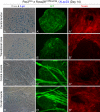A contemporary atlas of the mouse diaphragm: myogenicity, vascularity, and the Pax3 connection
- PMID: 22723526
- PMCID: PMC3524553
- DOI: 10.1369/0022155412452417
A contemporary atlas of the mouse diaphragm: myogenicity, vascularity, and the Pax3 connection
Abstract
The thoracic diaphragm is a unique skeletal muscle composed of costal, crural, and central tendon domains. Although commonly described in medical textbooks, newer insights into the diaphragm cell composition are scarce. Here, using reporter mice, combined with gene expression analyses of whole tissues and primary cultures, we compared the diaphragm domains and their myogenic progenitors (i.e., Pax3/7 satellite cells). The outcomes of these analyses underscore the similarities between the myogenic aspects of the costal and crural domains. Expression levels of all myogenic genes examined (except Pax3) were strongly affected in mdx (dystrophin-null) mice and accompanied by an increase in fibrosis- and adiposity-related gene expression. Cell culture studies further indicated the presence of a non-myogenic Pax3-expressing population, potentially related to vascular mural cells. We additionally investigated the diaphragm vasculature. XLacZ4 and Sca1-GFP transgenes allowed a fine definition of the arterial and microvasculature network based on reporter expression in mural cells and capillary endothelium, respectively. We also provide insights into the organization of the diaphragm venous system, especially apparent in the central tendon and exhibiting arcades lined with fat-containing cells. The novel information in this "contemporary atlas" can be further explored in the context of diaphragm pathology and genetic disorders.
Conflict of interest statement
Figures








References
-
- Anderson JE, Garrett K, Moor A, McIntosh L, Penner K. 1998. Dystrophy and myogenesis in mdx diaphragm muscle. Muscle Nerve. 21:1153–1165 - PubMed
-
- Anraku M, Shargall Y. 2009. Surgical conditions of the diaphragm: anatomy and physiology. Thorac Surg Clin. 19:419–429 - PubMed
-
- Armulik A, Genove G, Betsholtz C. 2011. Pericytes: developmental, physiological, and pathological perspectives, problems, and promises. Dev Cell. 21:193–215 - PubMed
Publication types
MeSH terms
Substances
Grants and funding
LinkOut - more resources
Full Text Sources
Other Literature Sources
Molecular Biology Databases

